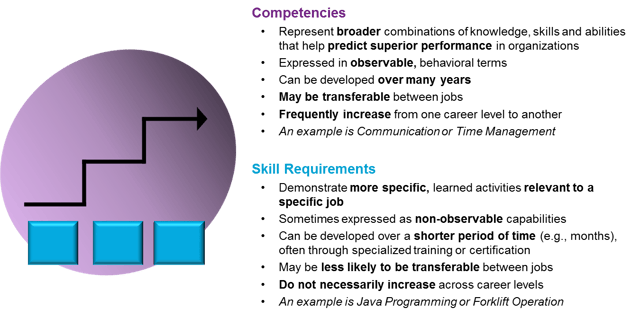Employees rank the opportunity to learn new skills among the top five drivers of attraction and retention (2016 Willis Towers Watson Global Workforce Study – U.S.). What does this really mean for organizations? If you think about the many jobs and functions of an organization, and break down all of the possible skills associated with those jobs, you could end up with an overwhelming list of hundreds of things to develop, measure and manage.
Let’s think of a specific example: your IT team alone may have skills such as database management, technical writing, quality control, project planning, and software knowledge. As your organization grows and evolves in today’s change-friendly landscape, additional skills may be needed and current skills may become outdated. While it’s important to track and manage skills specific to key jobs over time, organizations will need to focus on competencies – qualities that can help individuals grow in their careers beyond the current job. In other words, both skills and competencies are important.
Many say that skills and competencies are one in the same, and in fact, sometimes there isn’t a “black and white” distinction between the two. But here’s how I see it:

Why Competencies?
Competencies have long been used as a framework to help focus employees’ behavior on things that matter most to an organization and help drive success. They can provide a common way to harmonize, select and develop talent. The benefits are clear for employees and managers, and ultimately, the organization.
- For employees, competencies offer a description of the standards of excellence for current roles and potential future roles – in other words, they describe what “great” performance looks like.
- For managers, they provide resources to help them select and develop employees, and provide language to guide performance feedback.
- For organizations, they provide an action-oriented translation of what it looks like to demonstrate the values that are key to success.
Things to consider when it comes to an off-the-shelf competency solution
There are many off-the-shelf competency libraries or dictionaries out there, but it’s important to keep in mind a few things before going down this route.Which competency product should I choose?
- Anyone can throw together a list of behaviors that might be important to an organization, but consider whether the competencies in your off-the-shelf solution are future-focused and cover things that are really relevant to success. Are the competencies organized in a logical framework that works for your organization? Is it supported by research showing that those competencies are related to success?
Does the product allow customization?
- Make sure the product comes in a format that you can easily customize if necessary. For example, do you use the word “associates” instead of “employees”? Is there a specific phrase or value word that you’d like to sprinkle in? In short, you want something that’s editable so you have the opportunity to really make it your own.
Which competencies should be selected? Look for BYOCM.
- You may not need all the competencies within an off-the-shelf solution. And that’s OK. The best competency models are succinct and often fit on a single page. To get started, think about the strategic priorities of your organization. Is it customer service? Efficiency and speed? High quality products and solutions? Driving innovation? Competencies that are aligned to the overall strategic focus of an organization should be relevant across all jobs in order to achieve excellence. That said, consider whether you have the option of purchasing only what you need for your organization. You should be able to leverage a subset of a dictionary if your organization already has a good idea of what’s important to success. In other words, you should be able to BYOCM – Build your own competency model.
How do the selected competencies link to the organization’s employee development?
- Ideally, creating or refreshing a competency model is the first step in a transformation that can apply to other talent management areas. Competencies will be most successful if used for sourcing candidates, selection and onboarding, performance management, learning and development, assessment and promotion. Consider an off-the-shelf solution that provides additional resources or tools such as a behavioral interview guide, an assessment or a development guide. When a solution offers these additional pieces, you have the option of integrating competencies across the employment lifecycle, and ultimately, building a more sustainable model.
That last bullet point is actually really important. I have some thoughts on how competencies can be used in a career development framework and how competency-based interview questions can improve your current candidate interview process. But that’s another conversation for a later time – stay tuned.
For now, please check out our off-the-shelf competency solutions.



